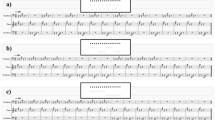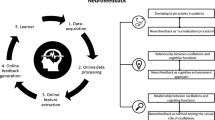Abstract
We trained four right-handed male subjects to detect small changes in the frequency of 21 Hz electrical stimulation applied to digits 2+3+4 of the right hand for 4 hours. Before and after the training, we recorded magnetoencephalographic (MEG) signals when the stimulation was applied to digit 2-5 separately using a whole-head MEG system. We applied tomographic analysis to the MEG data to track the evolution of activity over the entire brain every 1.6 ms and evaluated the change for each digit before and after the training. In summary: (1) subjects improved in discrimination performance with training; (2) activations were identified in the left primary somatosensory (L-SI) and medial parietal precuneus (PCu) areas, but no systematic changes were observed in location and strength of activation of these two areas; (3) after training in L-SI, the 21 Hz spectral power increased for digits 3 and 4 over the stimulation period, while the 10 Hz spectral power increased for digit 3 around stimulus onset and offset; (4) only digit 3 showed significant change of correlation between L-SI and PCu areas around the stimulus onset and offset, coincident with the increased 10 Hz spectral power. Our results suggest that short-term plasticity is associated with changes in timing and interaction between cortical areas
Similar content being viewed by others
References
Braun, C., Schweizer, R., Elbert, T., Birbaumer, N. and Taub, E. Differential activation in somatosensory cortex for different discrimination tasks. J. Neurosci., 2000a, 20: 446–450.
Braun, C., Wilms, A., Schweizer, R., Godde, B., Preissl, H. and Birbaumer, N. Activity patterns of human somatosensory cortex adapt dynamically to stimulus properties. Neuroreport, 2000b, 11: 2977–2980.
Braun, C., Heinz, U., Schweizer, R., Wiech, K., Birbaumer, N. and Topka, H. Dynamic organization of the somatosensory cortex induced by motor activity. Brain, 2001, 124: 2259–2267.
Ioannides, A.A., Bolton, J.P.R. and Clarke, C.J.S. Continuous probabilistic solutions to the biomagnetic inverse problem. Inverse Problem, 1990, 6: 523–542.
Ioannides, A.A., Taylor, J.G., Liu, L.C., Gross. J. and Müller-Gärtner H-W. The influence of stimulus properties, complexity, and contingency on the stability and variability of ongoing and evoked activity in human auditory cortex. NeuroImage, 1998, 8: 149–162.
Lehtelä, L., Salmelin, R. and Hari, R. Evidence for reactive magnetic 10-Hz rhythm in the human auditory cortex. Neurosci. Lett., 1997, 222: 111–114.
Liu, L.C., Fenwick, P.B.C., Laskaris, N.A., Schellens, M., Poghosyan, V., Shibata, T. and Ioannides, A.A. The human SI response contains components related to stimulus fre-quency and perception in a frequency discrimination task. Neuroscience, 2003, 121: 141–154.
Pleger, B., Dinse, H.R., Ragert, P., Schwenkreis, P., Malin, J.P. and Tegenthoff, M. Shifts in cortical representations predict human discrimination improvement. PNAS, 2001, 98: 12255–12260.
Pfurtscheller, G. and Lopes da Silva, F.H. Event-related EEG/MEG synchronization and desynchronization: basic principles. Clin. Neurophysiol., 1999, 110: 1842–1857.
Rioul, O. and Vetterli, M. Wavelets and signal processing. IEEE SP magazine, 1991, October: 14–37.
Schwenkreis, P., Pleger, B., Höffken, O., Malin, J.P. and Tegenthoff, M. Repetitive training of a synchronised movement induces short-term plastic changes in the human primary somatosensory cortex. Neurosci. Lett., 2001, 312: 99–102.
Spengler, F., Roberts, T.P.L., Poeppel, D., Byl, N., Wang, X., Rowley, H.A. and Merzenich, M.M. Learning transfer and cortical reorganization in humans trained in a tactile discrimination task. Neurosci. Lett., 1997, 232: 151–154.
Tobimatsu, S., Zhang, Y.M. and Kato, M. Steady-state vibration somatosensory evoked potentials: physiological characteristics and tuning function. Clinical Neurophysiology, 1999, 110: 1953–1958.
Wang, X., Merzenich, M.M., Sameshima, K. and Jenkins, W.M. Remodeling of hand representation in adult cortex determined by timing of tactile stimulation. Nature, 1995, 378: 71–75.
Xerri, C., Coq, J.O., Merzenich, M.M. and Jenkins, W.M. Experience-induced plasticity of cutaneous maps in the primary somatosensory cortex of adult monkeys and rats. J. Physiology (Paris), 1996, 90: 277–287.
Ziemus, B., Huonker, R., Haueisen, J., Spengler, F. and Weiller, C. Effects of passive tactile coactivation on median ulnar nerve representation in human SI. Neuroreport, 2000, 11: 1285–1288.
Author information
Authors and Affiliations
Rights and permissions
About this article
Cite this article
Liu, L., Ioannides, A.A. MEG Study of Short-Term Plasticity Following Multiple Digit Frequency Discrimination Training in Humans. Brain Topogr 16, 239–243 (2004). https://doi.org/10.1023/B:BRAT.0000032858.36816.98
Issue Date:
DOI: https://doi.org/10.1023/B:BRAT.0000032858.36816.98




